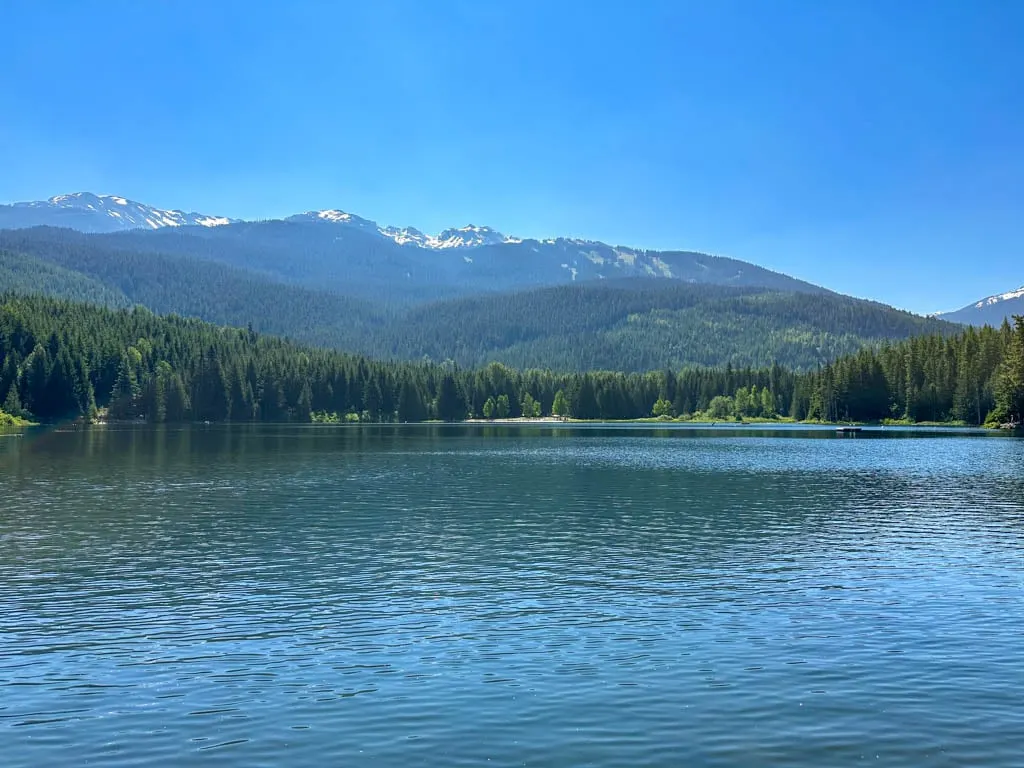Whistler’s Lost Lake Park is an easy place to love. It has tons of hiking, biking, and walking trails plus a wonderful lake for swimming. It’s only a few minutes from busy Whistler Village, but it has a natural setting that feels miles away. Plus, unlike most things in Whistler, it’s free!
I’ve been visiting Whistler for years and these days I live just down the road in Squamish. Visiting Lost Lake is one of my favourite things to do in Whistler. It’s a great place to just chill out. The easy hiking and biking trails are great in summer, and in winter, I love to snowshoe at Lost Lake.
In this post, I’ve got everything you need to know to visit Lost Lake Park in any season. It includes:
- Lost Lake basics: best things to do, rules about dogs, where to food, bathrooms, and more
- A map of Lost Lake Park showing all the trails plus a custom Google map that I made that shows everything I mention in this post
- How to get to Lost Lake from Whistler Village by car, bus, walking, and biking as well as parking info
- Where to swim and hit the beach at Lost Lake
- Hiking at Lost Lake including my recommendation for the best route
- Mountain biking and cycling at Lost Lake
- Lost Lake Disc Golf Course
- Fishing at Lost Lake
- Cross-country skiing and snowshoeing at Lost Lake
- Indigenous context of the Lost Lake area
- History of Lost Lake Park
- Lost Lake Park FAQ: All your questions answered.
This is a sensitive wilderness area. Learn how to Leave No Trace to keep the wilderness wild. Make sure you are prepared by bringing the 10 Essentials. Get ready for adventure with this checklist of things to do before every hike.
Hey there: Some of the links in this post are affiliate links, which means I earn a small commission at no cost to you. Thanks for your support. -Taryn

Lost Lake Basics
Lost Lake is a large nature park right next to Whistler Village. In the summer it’s a popular spot for hiking, swimming, fishing, and mountain biking. In the winter, the park turns into a cross-country ski and snowshoe area.
Here’s everything you need to know about Lost Lake Park
Best things to do in summer: swimming, hiking, biking, fishing, disc golf
Best things to do in winter: cross-country skiing and snowshoeing
Bathrooms: At the main beach and at Passivhaus in the southwest corner of the park
Dogs: Allowed on leash everywhere in the park except at the main beach. Dogs are allowed off-leash at Canine Cove dog beach on the east side of the lake.
Food: There is a small concession at the main beach and in the summer there are food trucks sometimes. There is also a cafe in Passivhaus. Or Whistler Village is a short walk/bike ride away.
Not allowed: Smoking, alcohol, camping, and campfires
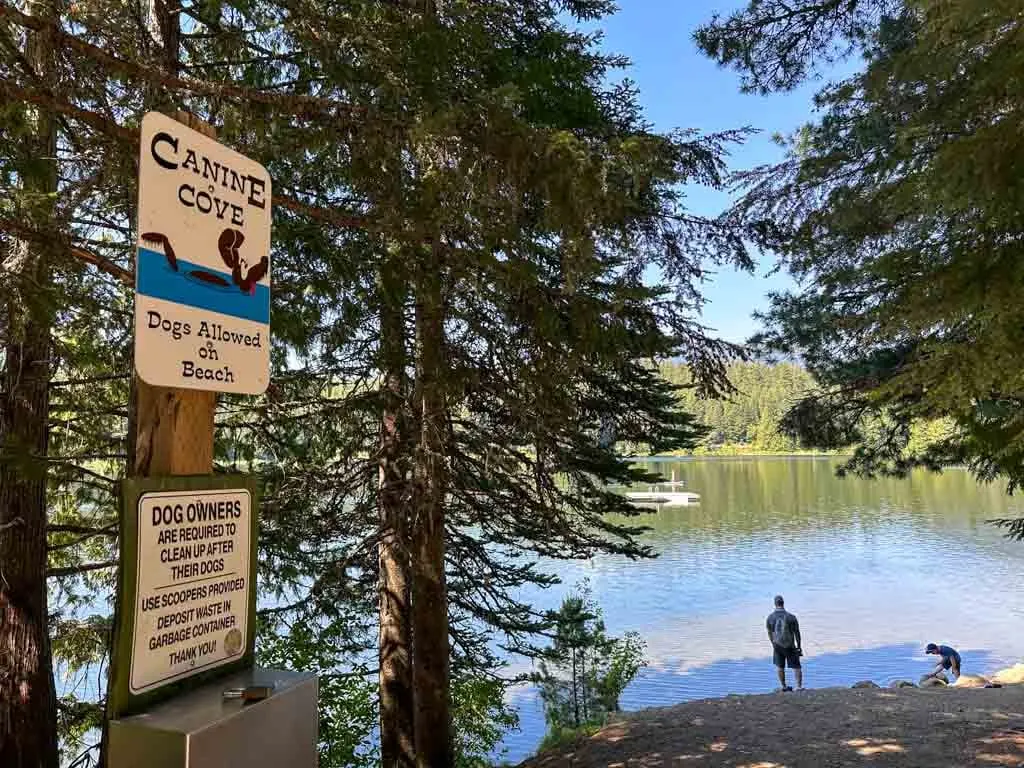
Lost Lake Park Maps
I made a custom Google Map for you that shows all the key places I mentioned in this post. Click on it to zoom in and explore.
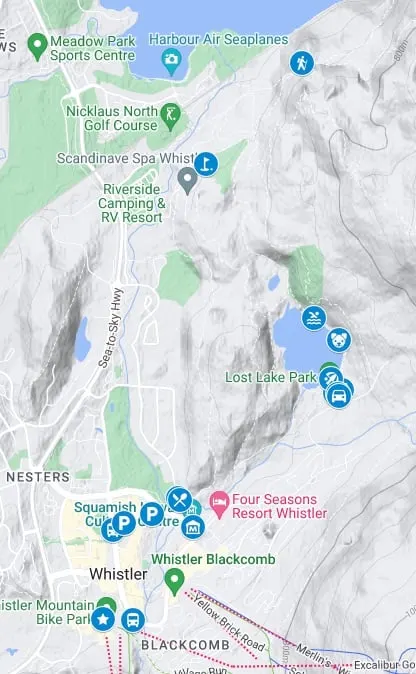
However, Google Maps sucks for navigating once you are in the park. There are maps of Lost Lake Park posted throughout the park and most trail junctions have good signs.
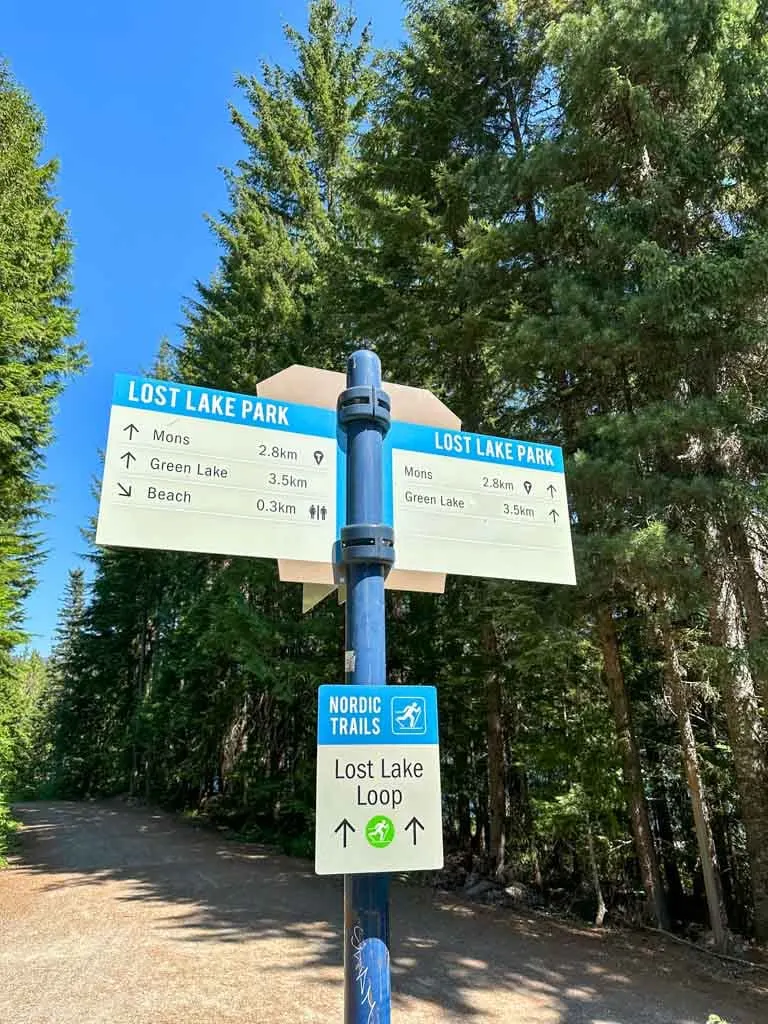
This map of Whistler Valley’s singletrack trails is also helpful. If you are mountain biking, download the Trailforks app since the trail network can get confusing.
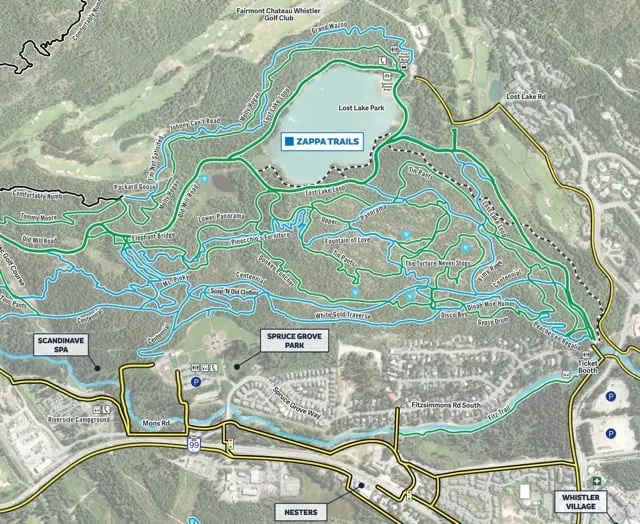
How to get to Lost Lake from Whistler Village
Lost Lake is easy to get to from Whistler Village by shuttle bus, walking or biking. However, it’s important to note that there is no parking at Lost Lake. You will need to park elsewhere, then bike, walk, or shuttle bus to Lost Lake. See the driving section and the parking section below for more info.
Some people hesitate to visit Lost Lake Park because you can’t drive there. But honestly, I think that’s what makes it so good – it isn’t as crowded as it could be if everyone drove. And it’s so easy to get there via trails or the shuttle that it’s not a big deal.
Shuttle Bus
In the summer (between late June and Labour Day), Whistler operates a free shuttle bus between Whistler Village and Lost Lake Park. The shuttle runs every 10-20 minutes and is wheelchair accessible.
You can catch the shuttle from the Olympic Plaza bus stop (which is right next to Parking Lot 4) or the Gondola Transit Exchange near the Whistler gondola.
Walking and Biking
It’s easy to walk or bike to Lost Lake Park in Whistler. There are a few logical routes.
My preferred route is to take the paved Valley Trail from Whistler Village to the Lost Lake Passivhaus. From there, walk or bike the gravel Lost Lake Trail. This route is about 2 km long and takes about 25 min to walk or 10 minutes to bike.
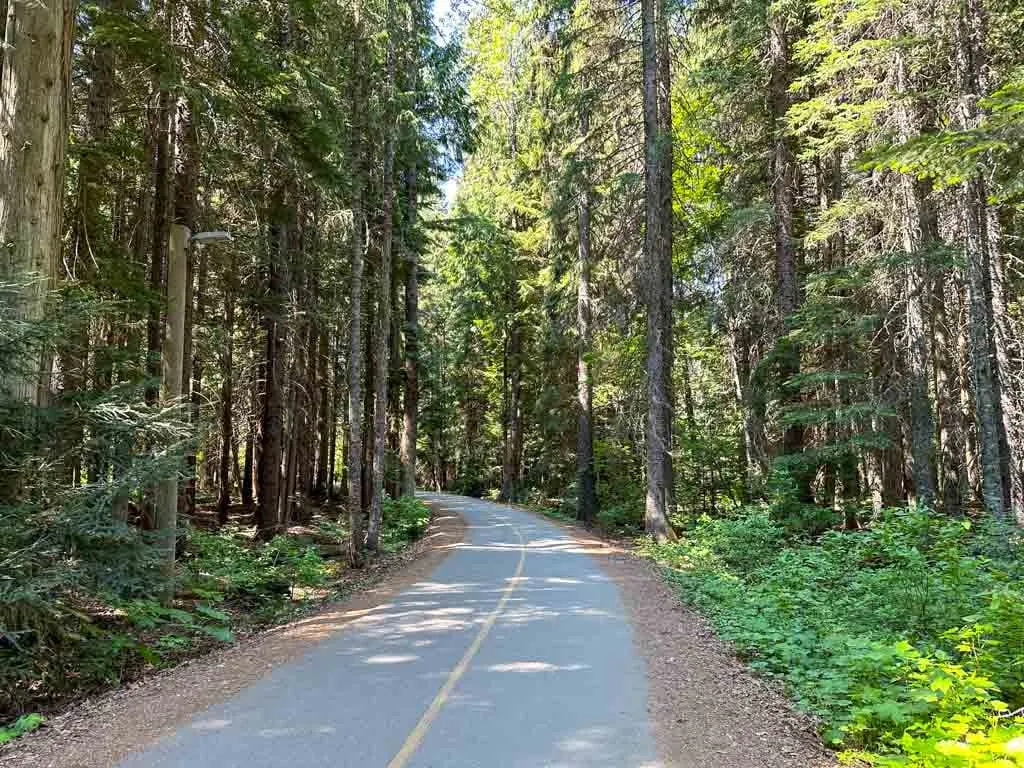
If you are walking, you can also take the Lost Lake Nature Trail, which runs parallel to the Lost Lake Trail and is a bit more interesting. It starts across from Passivhaus. It’s about the same distance as the Lost Lake Trail, but it’s quieter since it goes through the forest. It also has more ups and downs so it will take about 35 minutes instead of 25.
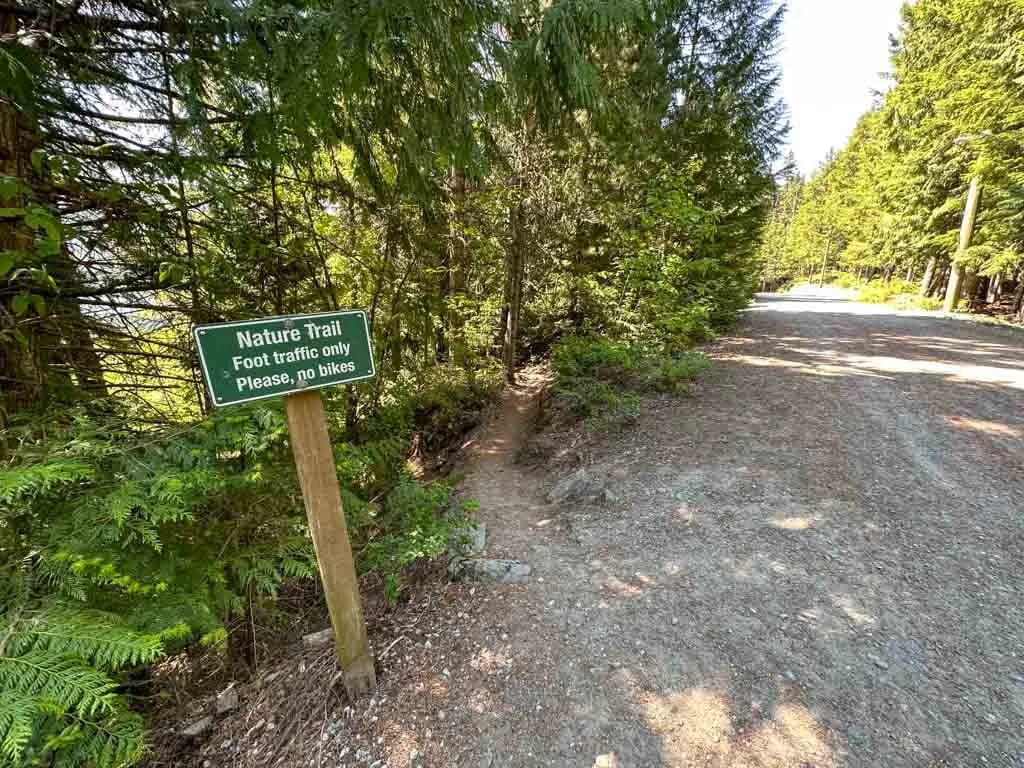
You can also walk or bike the Valley Trail from Whistler Village to the Passivhaus, then continue on the Valley Trail beside the Fairmont Chateau Whistler Golf Course to Lost Lake. This route is 2.1 km long and also takes 25 minutes to walk or 10 minutes to bike.
Use this map of the Valley Trail to plan your walking or biking route to Lost Lake from Whistler Village.
Driving
While you can drive to Lost Lake, you can’t park there. There is a small pick-up/drop-off area near the main beach if you want to drop people off.
To get there, go east (towards the village) on Lorimer Road from Highway 99. After crossing the bridge over Fitzsimmons Creek, turn left on Blackcomb Way. A few blocks later, turn left onto Lost Lake Road. There is currently no sign for this street, so I recommend using Google Maps. Click here for Google Maps directions.
Parking
There is no parking at Lost Lake. However, you can park your car and then take the shuttle bus, walk, or bike to Lost Lake.
I recommend parking in Lot 4 or 5. Lot 4 is closest to the Olympic Plaza shuttle bus stop. Lot 5 is closest to the walking and biking routes to Lost Lake. As of 2023, parking in Lots 4 and 5 costs $2.50/hour or $8/day. Parking is free after 5pm.
You can also park in Lot 1 to take the shuttle from the Gondola Transit Exchange, but it’s more expensive ($3/hour or $14/day) than lots 4 and 5.
Click here for Google Maps driving directions to Lot 4. Click here for Google Maps driving directions to Lot 5.
Swimming and Beaches
Can you swim at Lost Lake in Whistler? Oh yes, you can! Lost Lake is one of the best places to swim in Whistler. The water is fairly warm, as far as Whistler lakes go (which means it is still a little chilly). But since all of Whistler’s lakes are fed by mountain streams, you can’t expect tropical waters. As well, there are no lifeguards.
There is one main beach at the southeast end of the lake. The beach is near the car pick-up/drop-off area, the washrooms, and the picnic area. The sandy beach is big and there is lots of grass nearby for lounging or picnicking. There are also picnic tables, bathrooms, and an outdoor shower here.
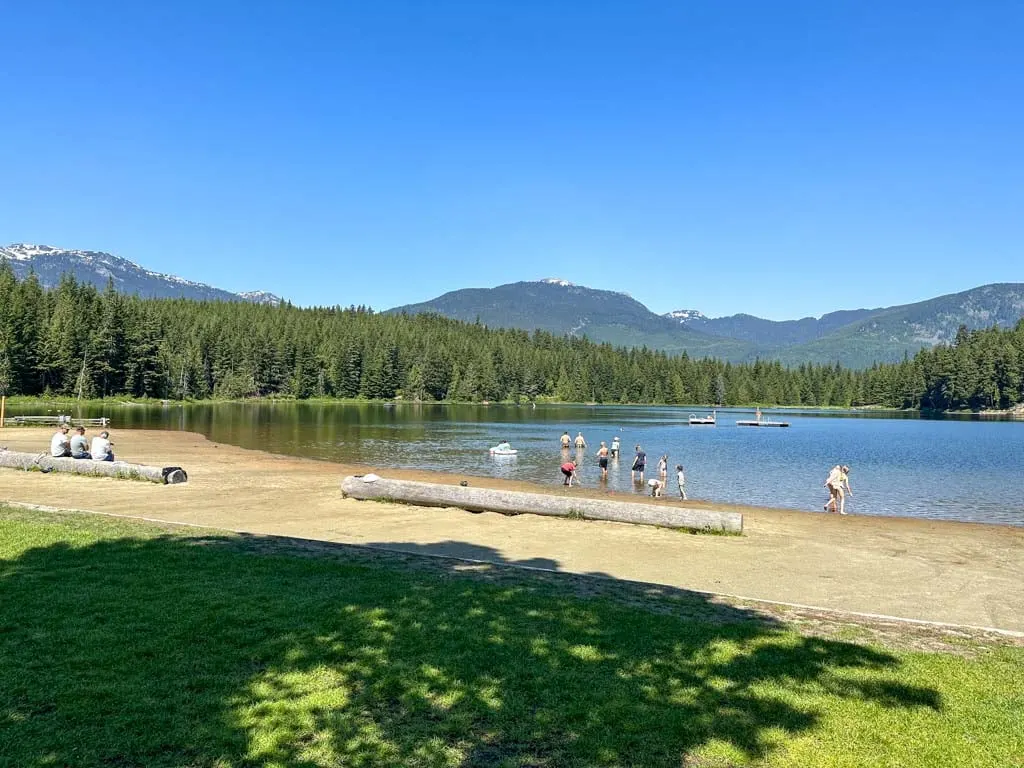
The main beach is not the only place to swim at Lost Lake. You can also swim from the big dock on the north side of the lake. It’s an easy 5-minute walk via the Lost Lake Loop Trail. There are also about half a dozen floating docks scattered around the lake. (It’s worth noting that one of them is often used by nudists.)

Another option is to follow the Lost Lake Loop Trail and its offshoots around the lake to find lots more swimming spots. There is no beach, but it’s easy to find places to wade or jump into the water.
Hiking at Lost Lake
While some of Whistler’s hiking trails can be pretty hardcore, the hikes at Lost Lake are pretty laid-back. The main hiking route at Lost Lake is an easy loop using the Nature Trail, then the Lost Lake Loop to circle the lake. The entire route is 4.5 km long with 55 m of elevation gain. Plan to spend about 1.5 hours.

The entire trail system at Lost Lake is multi-use, which means you can hike on any of the trails. However, expect to share them with mountain bikers, some of whom will be moving very quickly. Watch and listen for hikes behind you and ahead of you on the trail. Move over as they may not be able to stop suddenly. I recommend using the Trailforks app to navigate the multi-use trails.
If you are going to explore the multi-use trails, I recommend heading to the Green Lake Lookout. It’s a beautiful bluff top viewpoint above the light green waters of Green Lake. To get there, follow Old Mill Road north, then take Hydro Hill, then Green Lake Loop. Go left on the spur trail to the viewpoint.
Mountain Biking at Lost Lake
When you think of mountain biking in Whistler, most people think of the famous Whistler bike park. But there are also tons of mountain bike trails in Lost Park. There’s no lift, so you’ll have to pedal the uphills, but thankfully, the hills are never that steep. And the best part is the Lost Lake mountain bike trails are totally free.
You might hear locals refer to this area as the Zappa Trails. That’s because many of the trails have names that were inspired by Frank Zappa’s albums, songs, or lyrics. Examples include the three most popular trails: Pinocchio’s Furniture, Dwarf Nebula, and Zoot Allures.
Most of the trails are green (easy) and blue (moderate), so it’s a great place for beginners. The trails are mostly smooth single-track, but there are a few wooden features and sections of technical roots and rocks. It’s worth noting that most trails can be ridden in either direction, so expect 2-way traffic. Use the Trailforks app to navigate.
Cycling at Lost Lake
You don’t need to have a mountain bike to cycle at Lost Lake. There are wide and smooth gravel trails that are easy to ride with any bike. I’ve ridden my road bike through here and it’s lots of fun.
The loop around Lost Lake starting from Passivhaus is a great ride. You can also ride through Lost Lake Park down to the water at Green Lake via the Old Mill Road Trail, then loop back to the village on the Valley Trail. Use the Valley Trail map to plan your route.
Lost Lake Disc Golf Course
The Lost Lake Disc Golf Course is one of my picks for the best free things to do in Whistler. You will need to bring your own disc, but otherwise, there are no fees. There are three 9-hole sections for a total of 27 holes. Find the course at the north end of Lost Lake Park near the intersection of Old Mill Road Trail and Hydro Cut Trail.
Fishing
With lots of shoreline and docks, Lost Lake is a great place to go fishing. The lake is home to rainbow trout and is one of the few lakes in Whistler where you are allowed to use live bait. The best fishing is in the early morning and late afternoon/evening. Make sure you read the local fishing regulations and get a fishing license before you go.
Lost Lake in Winter: Cross-Country Skiing and Snowshoeing
Each winter Lost Lake’s 25 kilometres of trails combine with trails across two nearby golf courses to create a huge 40-kilometre-long maze of cross-country ski and snowshoe trails. The trails are maintained by the Municipality of Whistler and there is a small fee to use them.
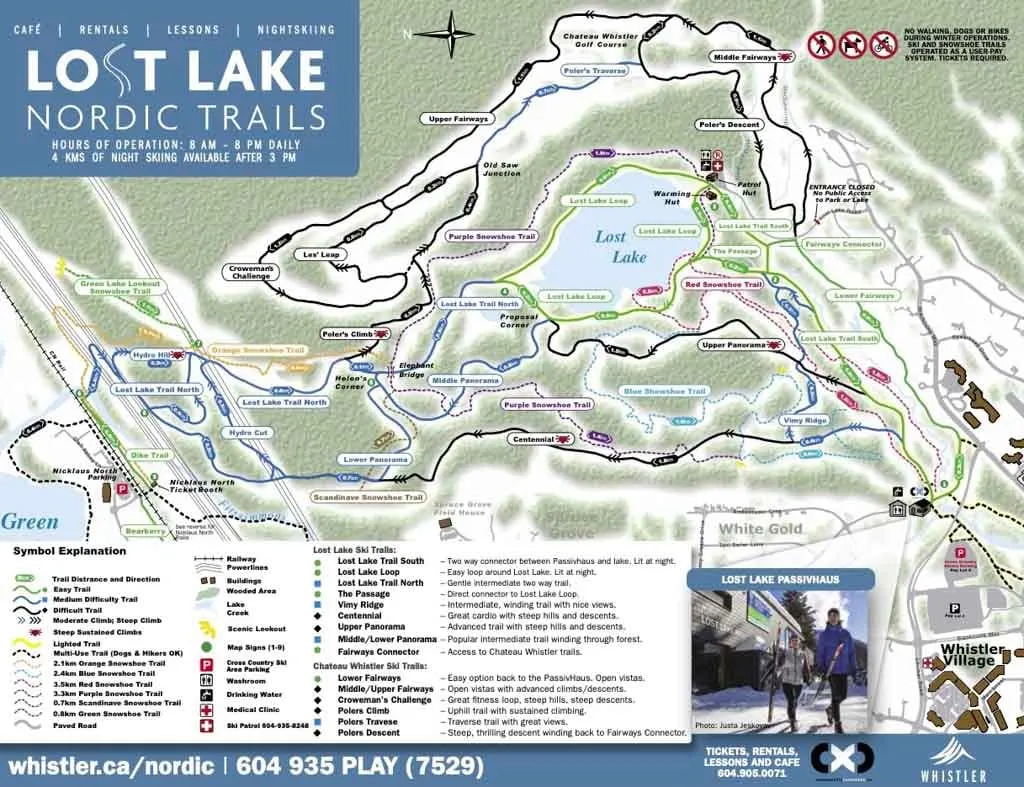
The rolling terrains and quiet trees of Lost Lake Park make it a chill contrast to the hustle and bustle of the nearby ski hill. I think that snowshoeing at Lost Lake is one of the best things to do in Whistler in winter.
The snowshoe around the lake is pretty, but I recommend going a little further to the Green Lake Viewpoint. My Lost Lake snowshoeing guide has all info you need to plan a trip.
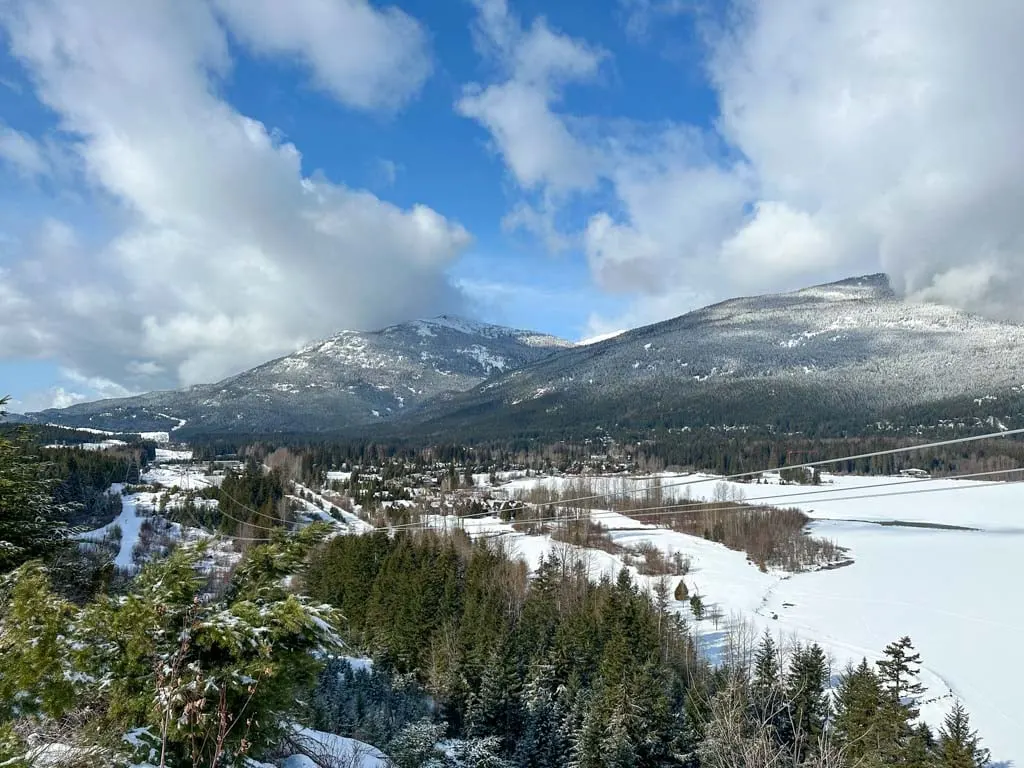
Indigenous Context
Like the rest of Whistler, Lost Lake is on the unceded traditional territories of the Lil’wat and Squamish First Nations who have lived in the area since time immemorial. In particular, the Lost Lake area was the territory of the Wolf Clan of the Lil’wat Nation. They had a trap line alongside nearby Fitzsimmons Creek.
The Squamish Lil’wat Cultural Centre is located just outside the park. I think that this incredible museum is one of the best things to do in Whistler since it helps you understand the culture and history of the local Indigenous people. I also love that each visit includes a guided tour with a member of one of the two nations. They explain the exhibits but also give their personal context and connection to their culture and history.
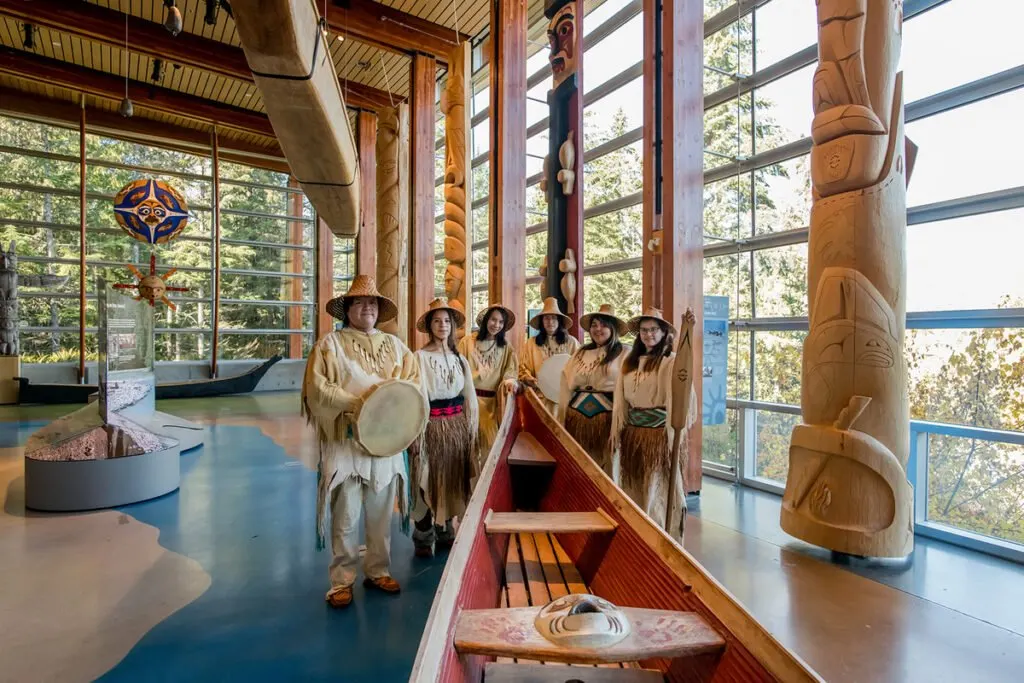
History of Lost Lake
When I was writing this post I did a bunch of research into the history of Whistler’s Lost Lake, hoping that I would find out why it is called “Lost”. Unfortunately, I didn’t find the answer to that question, but I did discover that the entire park was almost “lost”.
In the 1960s the whole area was slated to be logged. Local forest Don MacLaurin advocated for the lake to be saved as a park instead of being logged or sold to build waterfront homes like the other lakes in Whistler.
The cross-country ski trails were built in the 1970s and the beach area was cleared in the 80s. In the late 70s and early 80s, there was even a wooden ski jump that launched into the lake for summer practice. You can read more about the history of Lost Lake on the Whistler Museum blog. (Psst! A visit to the Whistler Museum is on my list of the best cheap things to do in Whistler.)

Lost Lake Park FAQ
There is no parking at Lost Lake so you will need to walk, bike or take the shuttle bus. See the Getting There section for more info.
Yes. The shuttle leaves from Whistler Village every 10-20 minutes. See the Getting There section for more info.
The loop around the lake takes about 1.5 hours. However, I recommend exploring more of the trails including the Green Lake Viewpoint, so plan to spend up to 3 hours. See the Hiking section for more info.
Yes. Lost Lake is one of the best places to swim in Whistler with warm(ish) water, a sandy beach, and lots of floating docks.
Yes. Dogs are allowed on-leash in most of the park. Dogs are not allowed at the main beach. BUT there is an off-leash dog beach called Canine Cove.
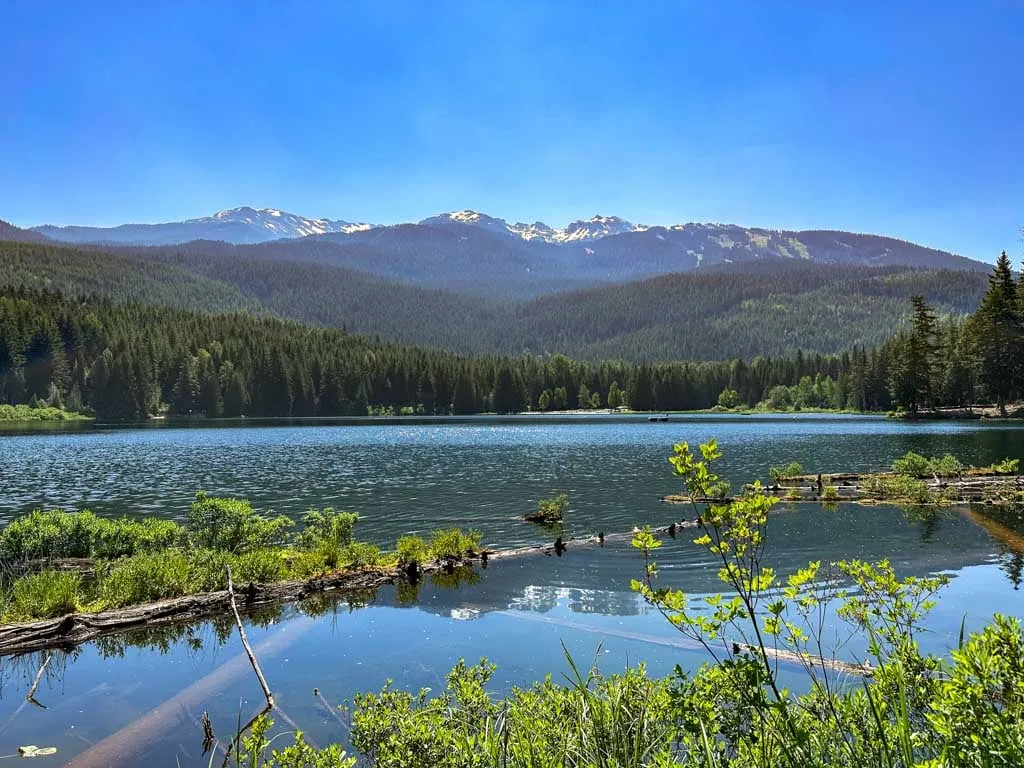
So that’s everything you need to know to visit Lost Lake Park in summer and winter. Is Lost Lake on your Whistler to-do list? Have questions about the park? Ask me in the comments.
More Whistler Posts:
- 80+ Things to Do in Whistler (By a Local)
- Visiting Whistler, BC in Summer (By a Local)
- 42 Cheap and Free Things to Do in Whistler
- Lost Lake Snowshoe Trails in Whistler
- The Best Hikes in Whistler: A Guide to All the Trails
- Lake O’Hara Packing Lists for Hikers and Campers - April 25, 2025
- BC Parks Day Passes 2025 – Everything You Need to Know - April 24, 2025
- Best Women’s Hiking Pants (Picks for Every Body Type) - April 21, 2025

